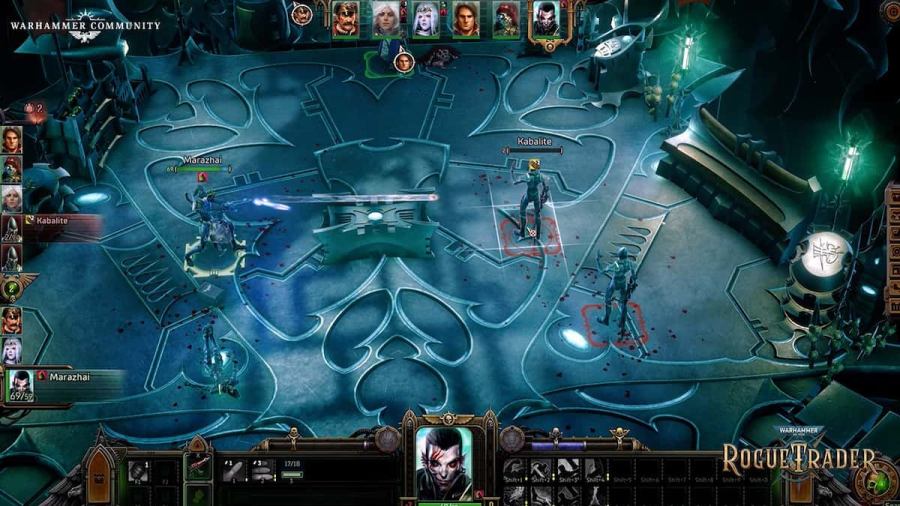Rogue Trader is a long-awaited CRPG iteration of a tabletop game I have known and loved since my early childhood. It was well-known for its complexity, so it's no wonder the game's difficulty perplexes players. Here are all Rogue Trader difficulty levels in this Warhammer 40k title.
What are the differences between Warhammer 40k Rogue Trader difficulty levels?
There are six base difficulty presets in Warhammer 40k: Rogue Trader:
- Custom: This difficulty level is completely user-defined. You can tweak your parameters to be as easy or as difficult as you choose.
- Story: This difficulty mode focuses on story narration without providing any significant challenges to the player. If you're looking to enjoy the game's narration or are completely unfamiliar with the world of CRPGs, this is the mode for you.
- Normal: If you're looking for a balanced experience without investing yourself too much into number-crunching, pick Normal.
- Core: This is perhaps the most balanced gameplay experience overall, with no attack damage modifiers or scaling applied to rolls. The game still doesn't recommend this game mode to newcomers, and I agree with that estimate.
- Hard: At this point, the game starts stacking odds against you by increasing the enemy stats and wounds they inflict on your party members. Only pick this difficulty if you're looking for a real challenge.
- Unfair: If you're looking for an ultimate challenge as a seasoned Rogue Trader, this game mode is for you. Odds will be stacked heavily against you as the party's momentum gains decrease significantly, and the enemies threaten you more seriously than ever.
What do the difficulty setting sliders do in Warhammer 40k Rogue Trader?
You encounter multiple difficulty sliders when starting a new game of Rogue Trader, which more thoroughly define your gameplay experience. Still, the game doesn't do a good job of explaining what they do. Here is the list:
- Enemy unit dodge modifier (+%): A value in percentages added to the base chance of an enemy's ability to use dodge to evade your attacks.
- Half cover hit bonus: Applies to all party members. This value increases your chance to hit enemies in partial cover.
- Full cover hit bonus: Applies to all party members. This value increases your chance to hit enemies in full cover.
- Party momentum gain modifier (+%): Party momentum stacks odds in your favor while in combat. The key is to reach 175 when any member can use a heroic act to steer the combat in their favor. Likewise, when your party momentum drops below 25, multiple negative effects will apply.
- Minimum damage health to enemies after reduction from armor and deflection: Defines a minimum amount of damage the enemies will take after all saving throws and deflection have been applied.
- Minimum damage health to enemies after reduction from armor and deflection(+%): Defines the minimum amount of damage the enemies will take after all saving throws and deflection have been applied, based on percentages. At the moment, it is still unknown how this value correlates with the value based on units.
Related: Idira Build Guide – Rogue Trader
- Minimum damage health to enemy ships after reduction from armor and deflection: Defines the minimum amount of damage the enemy ships will take after deflection has been applied.
- Minimum damage health to enemy ships after reduction from armor and deflection(+%): This value defines the minimum amount of damage the enemy ships will take after all deflection has been applied, based on percentages. At the moment, it is still unknown how this value correlates with the value based on units.
- NPC characteristic modifier (+%) Applies to all values that modify NPC characteristics.
- Max duration for hard crowd control effect on party (number of rounds): Determines the maximum number of rounds your characters can remain stunned or are otherwise disabled for attacking.
- Skill test difficulty modifier: Buffs or debuffs all skill tests your characters take in the game.
- Damage required to receive injury (% of wounds): Determines how many wounds a character must take to suffer an injury, defined in percentages of wounds.
- Number of rounds before a fresh wound becomes an old wound: Defines how many rounds you have before receiving an old wound from an untreated fresh wound.
- Number of injuries received before becoming a trauma (stacks): How many injuries you can stack without escalating to a trauma.
- Space combat difficulty: Determines the overall difficulty of void ship combats.
If you're looking to read more on Warhammer 40k: Rogue Trader, you've come to the right place! Take a look at Abelard Build Guide – Rogue Trader and Heinrix Build Guide – Rogue Trader, here on Pro Game Guides!
